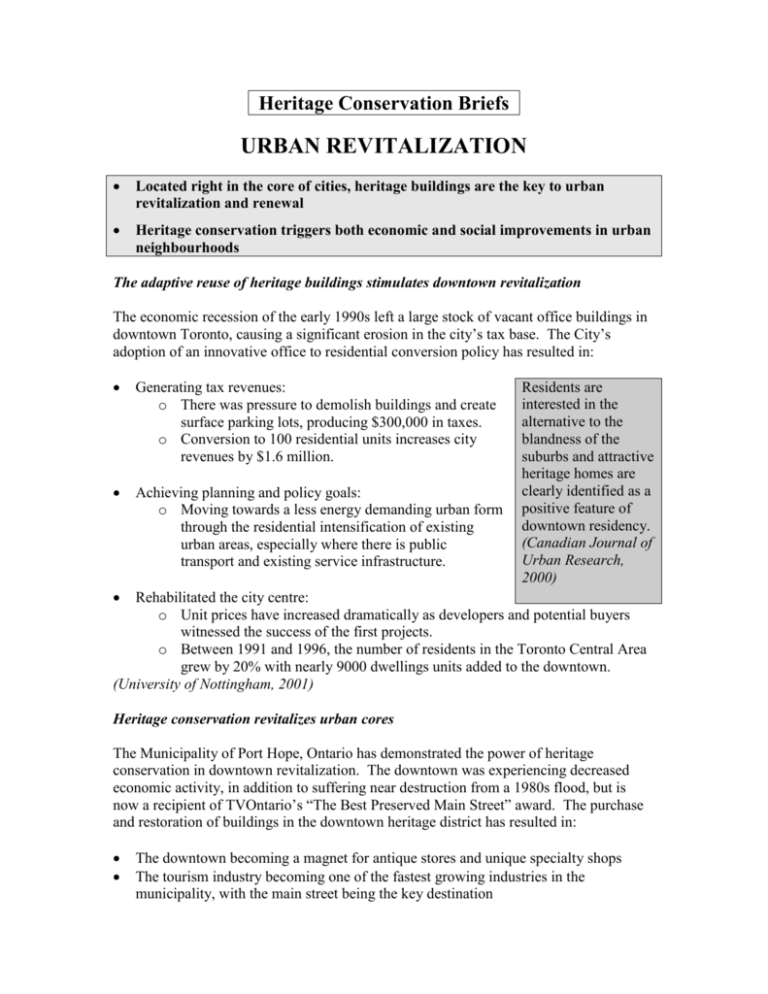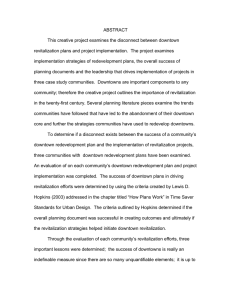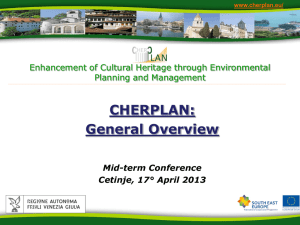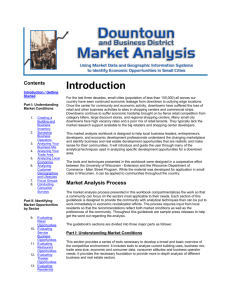Heritage Conservation Briefs
advertisement

Heritage Conservation Briefs URBAN REVITALIZATION Located right in the core of cities, heritage buildings are the key to urban revitalization and renewal Heritage conservation triggers both economic and social improvements in urban neighbourhoods The adaptive reuse of heritage buildings stimulates downtown revitalization The economic recession of the early 1990s left a large stock of vacant office buildings in downtown Toronto, causing a significant erosion in the city’s tax base. The City’s adoption of an innovative office to residential conversion policy has resulted in: Generating tax revenues: o There was pressure to demolish buildings and create surface parking lots, producing $300,000 in taxes. o Conversion to 100 residential units increases city revenues by $1.6 million. Achieving planning and policy goals: o Moving towards a less energy demanding urban form through the residential intensification of existing urban areas, especially where there is public transport and existing service infrastructure. Residents are interested in the alternative to the blandness of the suburbs and attractive heritage homes are clearly identified as a positive feature of downtown residency. (Canadian Journal of Urban Research, 2000) Rehabilitated the city centre: o Unit prices have increased dramatically as developers and potential buyers witnessed the success of the first projects. o Between 1991 and 1996, the number of residents in the Toronto Central Area grew by 20% with nearly 9000 dwellings units added to the downtown. (University of Nottingham, 2001) Heritage conservation revitalizes urban cores The Municipality of Port Hope, Ontario has demonstrated the power of heritage conservation in downtown revitalization. The downtown was experiencing decreased economic activity, in addition to suffering near destruction from a 1980s flood, but is now a recipient of TVOntario’s “The Best Preserved Main Street” award. The purchase and restoration of buildings in the downtown heritage district has resulted in: The downtown becoming a magnet for antique stores and unique specialty shops The tourism industry becoming one of the fastest growing industries in the municipality, with the main street being the key destination The downtown core becoming a sustainable district within itself The virtual extinction of vacant storefronts A storefront being restored into a Performing Arts Centre, expected to produce spin offs of $3 million and many new local jobs (University of Waterloo, 2003) In an era of homogenized Heritage conservation triggers positive economic retail businesses, malls, changes and office parks, older downtowns, with their The rehabilitation of the Stanley Theatre in Vancouver, compact assemblage of British Columbia caused the surrounding area to functions and their often experience the following socio-demographic and business unique merchandise and changes: services, are yet another differentiating natural asset that can be capitalized on Restaurants, cafes, and bars increased by 21% by communities trying to Cultural establishments increased by 9% bolster their economies. Retail sale increased by 107.7%, or $112 million (Housing Policy Debate, Real estate price increased by 72% and a doubling of 1998) condo prices, outstripping Vancouver residential market increases Building permits to increase from 1% to 16% of the permits issued in the general area 100% of business respondents said that business volume was up since the rehabilitation project had been completed (Ryerson University, 2003) Resources Bunting, T.E. 2000. Housing Strategies for Downtown Revitalization in Mid-Size Cities: A City of Kitchener Feasibility Study. Canadian Journal of Urban Research. 9(2): 145175. Goddard-Bowman, R. 2003. Something Old is Something New: The Role of Heritage Preservation in Economic Development. Papers in Canadian Economic Development. Volume 9. Economic Development Program, University of Waterloo. P.122. Heath, T (University of Nottingham). 2001. Adaptive Re-Use of Offices for Residential Use. Cities. 18(3): 173-184. Jones, K. et al. 2003. Beyond Anecdotal Evidence: The Spillover Effects of Investments in Cultural Facilities. Ryerson University. Listokin, D., B. Listokin, and M. Lahr (Rutgers University). 1998. The Contributions of Historic Preservation to Housing and Economic Development. Housing Policy Debate. 9(3): 431-478.











